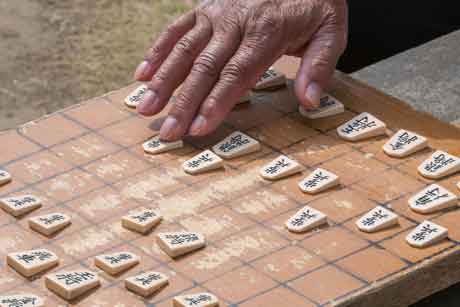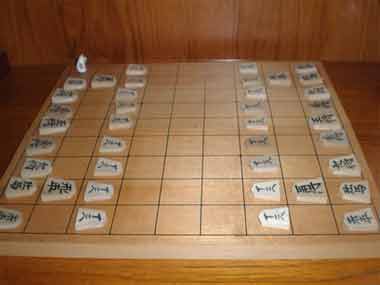There are many versions and variants of the game called chess. All of these can be traced back to 7th-century India and a game called Chaturanga. From there it spread to other countries, eventually reaching the West, and became what America and Europe refer to as Chess or International Chess and Japan where it is called Shogi. Today, these two have conquered the world from both ends and are the dominant versions of the game. While there are many variants on Shogi, the rules and set-up discussed below will only pertain to the original standard. So, read this review article for play chess online.
For western players crossing the Pacific to pick-up this gem from the Land of the Rising Sun it is imperative to have a guide for recognizing shogi pieces by their Japanese characters. All shogi game pieces look exactly the same, the only way to tell them apart is their distinguishing characters. Imagine that all chess pieces looked the same, but had “PAWN” and “ROOK” written on top.

Set-up and Pieces
In Shogi, several pieces and their movements translate from International Chess. The difference is in their power. For example there is no queen, but there are one rook and bishop that when promoted are the most devastating pieces on the board. Apart from the rook are lances, which do get placed on the farthest squares opposite the king and can move as many distances forward to capture a piece as they can. However, they can only move forward and cannot go backwards, severely limiting their use.
Since Japanese Chess is played on a 9×9 board players use their rows to set-up their pieces instead of only two. In the first row the king is placed in the center. To his right and left stand the gold generals. Next in line are the silver generals then the two knights and finally the lances. In the second row the bishop is placed to the king’s left and the rook to his right. The third row consists of the nine pawns. The pawns are also very similar to their western counter-part; they are the first line of defense and usually the most easily sacrificed.
Movements
A king remains a king; he moves one space in any direction and can capture all enemy pieces adjacent to him. The rest of the pieces move like their western counterparts, but in each case with less fluidity. For example, a knight in shogi still hops two up and one over, however, in shogi this is all the knight can do. He, along with the lance and pawn, may never move backwards in the game. The knight has further restrictions; he cannot move forward by moving over two and up one, but must always jump forward by two spaces. The lance as mentioned above can only move forward, but he is allowed to jump as many spaces as he wants. The lance and pawn are similar in this regard in that pawns can only move forward one space at a time. In shogi, pawns do not capture pieces diagonally, they can only do so by forward movement.
Next in line are the pieces foreign to a western audience: the gold and silver generals. These four pieces are extremely powerful in a quite ordinary way, but in the hands of a skilled player form the true backbone of shogi defense and offense strategies. The golds, considered more of defensive pieces, flank each side of their king. They can move to the three spaces in front of them, move to the two spaces beside them, and retreat to the space immediately behind them. While hardly a very mobile unit, they are very hard to get around. Next to them, the silvers, act somewhat the same, but lose the ability to sidestep into the space next to them or move directly backwards. However, unlike the golds, they can move diagonally backwards making them more useful while attacking.
It’s understandable that western players new to shogi might be feeling a little lost without any definable queen on the board. Soon this confusion shall fade when they realize that they have been given two replacements for her majesty. The single bishop and rook, dueling the middle line of set-up are the most devastating pieces in the game.
Here’s an informal hint: if you lose both these pieces to the enemy at the same time you might as well just quit.
Surprisingly the rook and bishop move exactly like they do in chess without variance. It is only when promoted that their true weight can be thrown around on the battlefield. A promotion occurs at the player’s will when he or she has moved a piece into enemy territory (the last three rows opposite him). Knights, lances, and pawns promote to gold generals. A silver general will also promote to a gold general, however, several players choose to keep them silver so they can retain their ability for backwards diagonal movement. The king and his gold generals do not promote. A promoted rook is called a Dragon King and retains his original abilities as well as being able to move one space in any diagonal direction. The promoted bishop, or Dragon Horse, does the same, retaining his powers plus gaining forwards, backwards, and side-to-side single space movements.

Capturing and Dropping
In shogi, pieces never “die” they are instead captured. This is the main distinction and separation shogi has with chess. It also completely changes the game. If chess is a challenging game, shogi is a brutal one. The more powerful the piece that is captured the more perilously the position of its former player. Captured pieces can be placed almost anywhere on the board, with a few exceptions. Pawns, lances, and knights can not placed where they cannot move, i.e., the back of the board. A pawn cannot drop onto a line occupied by an enemy pawn. Players cannot capture pieces with a drop nor can they checkmate with a drop. Lastly (and obviously), a drop constitutes a player’s turn; one drop per turn is allowed.
Shogi Checkmates
As in chess, the same in shogi. Simply corner your opponent’s king.
Shogi strategies can be quite complicated and should be studied in some detail by any player before attempting to play.


